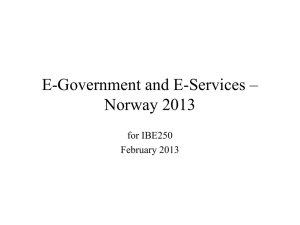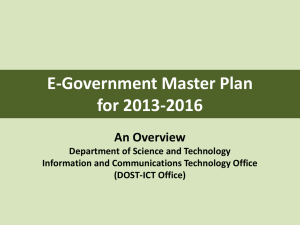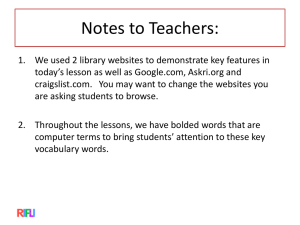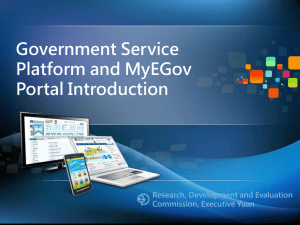In order to see how the 70 cities ranked overall, we created a zero to
advertisement
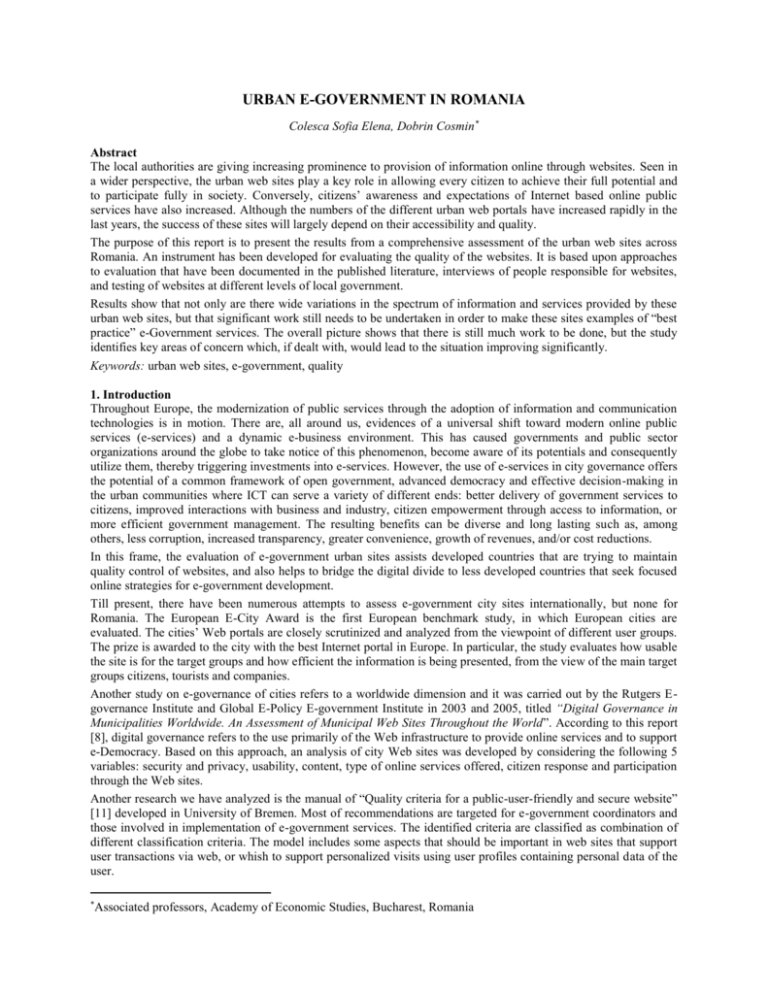
URBAN E-GOVERNMENT IN ROMANIA Colesca Sofia Elena, Dobrin Cosmin* Abstract The local authorities are giving increasing prominence to provision of information online through websites. Seen in a wider perspective, the urban web sites play a key role in allowing every citizen to achieve their full potential and to participate fully in society. Conversely, citizens’ awareness and expectations of Internet based online public services have also increased. Although the numbers of the different urban web portals have increased rapidly in the last years, the success of these sites will largely depend on their accessibility and quality. The purpose of this report is to present the results from a comprehensive assessment of the urban web sites across Romania. An instrument has been developed for evaluating the quality of the websites. It is based upon approaches to evaluation that have been documented in the published literature, interviews of people responsible for websites, and testing of websites at different levels of local government. Results show that not only are there wide variations in the spectrum of information and services provided by these urban web sites, but that significant work still needs to be undertaken in order to make these sites examples of “best practice” e-Government services. The overall picture shows that there is still much work to be done, but the study identifies key areas of concern which, if dealt with, would lead to the situation improving significantly. Keywords: urban web sites, e-government, quality 1. Introduction Throughout Europe, the modernization of public services through the adoption of information and communication technologies is in motion. There are, all around us, evidences of a universal shift toward modern online public services (e-services) and a dynamic e-business environment. This has caused governments and public sector organizations around the globe to take notice of this phenomenon, become aware of its potentials and consequently utilize them, thereby triggering investments into e-services. However, the use of e-services in city governance offers the potential of a common framework of open government, advanced democracy and effective decision-making in the urban communities where ICT can serve a variety of different ends: better delivery of government services to citizens, improved interactions with business and industry, citizen empowerment through access to information, or more efficient government management. The resulting benefits can be diverse and long lasting such as, among others, less corruption, increased transparency, greater convenience, growth of revenues, and/or cost reductions. In this frame, the evaluation of e-government urban sites assists developed countries that are trying to maintain quality control of websites, and also helps to bridge the digital divide to less developed countries that seek focused online strategies for e-government development. Till present, there have been numerous attempts to assess e-government city sites internationally, but none for Romania. The European E-City Award is the first European benchmark study, in which European cities are evaluated. The cities’ Web portals are closely scrutinized and analyzed from the viewpoint of different user groups. The prize is awarded to the city with the best Internet portal in Europe. In particular, the study evaluates how usable the site is for the target groups and how efficient the information is being presented, from the view of the main target groups citizens, tourists and companies. Another study on e-governance of cities refers to a worldwide dimension and it was carried out by the Rutgers Egovernance Institute and Global E-Policy E-government Institute in 2003 and 2005, titled “Digital Governance in Municipalities Worldwide. An Assessment of Municipal Web Sites Throughout the World”. According to this report [8], digital governance refers to the use primarily of the Web infrastructure to provide online services and to support e-Democracy. Based on this approach, an analysis of city Web sites was developed by considering the following 5 variables: security and privacy, usability, content, type of online services offered, citizen response and participation through the Web sites. Another research we have analyzed is the manual of “Quality criteria for a public-user-friendly and secure website” [11] developed in University of Bremen. Most of recommendations are targeted for e-government coordinators and those involved in implementation of e-government services. The identified criteria are classified as combination of different classification criteria. The model includes some aspects that should be important in web sites that support user transactions via web, or whish to support personalized visits using user profiles containing personal data of the user. * Associated professors, Academy of Economic Studies, Bucharest, Romania The explosion of urban e-government sites has determined the need of measurement criteria to evaluate aspects related to the quality in use. The objective is to make a urban web site useful, profitable, citizen liking and accessible. So, in the following we will analyze which are the characteristics that should be considered. Our research is concerned with the key issue of quality. The concept of quality is multi-faced. One could distinguish, for instance, as many quality perspectives as stakeholders groups. Users are interested in the quality in use, which is mainly an external characteristic, while developers and managers are more concerned with issues like maintainability, portability, cost effectiveness, and so on, mainly related to internal quality. Web sites are generally evaluated from the users’ standpoint, so mainly considering external quality. So, quality evaluation approaches suffer from several limitations: They often define very general criteria, not addressing the specific type of site (informative, directory, service specific, etc.). These differences must be taken into account when measuring the characteristics of the sites, which should be appropriately weighted. For example, a link rich page can be considered a positive element for informative parts of a site, while could disturb in a service specific section/page, where the user should be driven to accomplish his/her task in a linear manner; Criteria are mainly qualitative; hence the evaluation can be error prone or controversial; Criteria are not orthogonal. Same characteristics are often considered more than once, so contributing to a higher or lower score, depending on they have been fulfilled or not; Many evaluation criteria are essentially accessibility or usability biased. Even if the two areas have some overlap, stressing one of them can be misleading. It occurs that a perfectly usable site is really not accessible, or that a technically accessible site may be scarcely usable; There is no clear distinction between page and site quality; The perception of the quality changes from different user perspectives: the final user is interested in external quality related to the usability and functionality of the site, while the developer is more interested to the internal quality related to backward and forward compatibility, openness to evolution, maintainability, portability, interoperability, etc. To encourage a common understanding of the underlying principles of the different structured quality models, the ISO/IEC 9126 international standard on “quality characteristics and guidelines for their use” has been published. It “provides a general purpose model which defines six broad categories of quality: functionality, reliability, usability, efficiency, maintainability, and portability. The six categories are further broken down into subcategories which have measurable attributes.” [6]. The first version of the ISO/IEC 9126 standard from 1991 has recently been revised resulting into the ISO/IEC 9126-1:2001, part 1 of the ISO/IEC 9126 international standard. Mainly changes in environment and advances in information technologies led to this revision; the standard is now divided into four parts, of which the first includes internal and external quality characteristics and sub-characteristics for quality in use and a guide to apply the model. The quality characteristics structure proposed by the ISO 9126 standard is outlined in Figure 1. Figure 1: The quality model of ISO/IEC 9126-1:2001 (Olsina [9]) An application of the ISO/IEC 9126 standard for specifying quality characteristics and attributes for Web sites is shown in [9]. Olsina together with a group of Argentinean researchers developed WEBQEM (Web Quality Evaluation Method), a method based on the evaluation and quantitative comparison of the quality of web sites. In our study the first 50 Romanian ranked urban websites were evaluated using the WEBQEM method. 2. Research methodology In this research, the urban web site is defined as the official website where information about city administration and online services are provided by the city. The city website includes websites about the city council, mayor and executive branch of the city. If there are separate homepages for agencies, departments, or the city council, we examined these sites whether were linked to the menu on the main city homepage. If the website was not linked, it was excluded from evaluation. The research has evaluated the effectiveness and quality of Romanian urban web sites in providing equitable and appropriate access to cities information. The research we have conducted was performed in two steps. In the first step, the main issue that the research focused upon was to minimize the number of evaluated urban websites and selection of representative urban web portals. First, a initial list of URLs (134 web sites from 267 cities in Romania) was taken from the following source: www.e-guvernare.ro. Each URLs was processed by first automatically retrieving a number of pages, starting from this home URL and progressively following hyperlinks to a pre-programmed depth (within each domain/site). The results were consolidated for each site and stored into a spreadsheet for detailed analysis. At this stage a number of sites were removed from further consideration, where sufficient data was not obtained for reliable investigation. This could arise for a variety of reasons: a site may have been relocated to a different domain; it might be temporarily out of service; it might rely on non-HTML navigation; it might require registration/login; it might be intrinsically a very small site. Building on the results and data provided by the automated assessments, we carried out an additional manual assessments. A mini-audit was performed on each of these sites to elicit areas of good practice using the following criteria, adapted from the manual “Quality criteria for a public-user-friendly and secure website” [11], developed at University of Bremen: Is easy to find the URL’s site? There are differences in the site view using different browsers? Is the ‘alt text’ provided meaningful? Are the contents accessible without installing specific viewing software (plug-ins)? If frames were used, are frame titles meaningful? Is the text a good default size, and can the text be resized in the browser? Can the web page be resized to 800x600 without any horizontal scrolling? Do the colors reflect personal settings? Are there any distracting or moving images? Does functionality still work when JavaScript is disabled? Is there an accessibility statement? Does a site map exist and is it useful? Has skip navigation been provided? Is the navigation clear and consistent? Is a FAQ list provided? Have page names been given appropriate names? The loading time is too long? There is a multilingual facility? The list of sites was ranked according to the number of passes and fails. In the next step, the first 50 ranked urban websites were evaluated using the WEBQEM method. WEBQEM (Web Quality Evaluation Method) is a method based on the evaluation and quantitative comparison of the quality of web sites, developed by a group of Argentinean researchers. The method is based on international quality standards. In evaluation of the urban web sites were considered the following quality characteristic requirements: usability, functionality, site reliability and efficiency. With the aim to assess the level of accomplishment of these characteristics, a quality requirement tree for urban web sites was adapted based on quality method for academic Web sites developed by Olsina [10]. A quality characteristic is decomposed in multiple levels of sub-characteristics, and in turn, a sub-characteristic is refined in a set of measurable attributes. Quality evaluation aggregates the measured attribute values. The proposed quality tree is presented in figure 2. 1. Usability (0.3) 1.1. Global site understandability (0.35) 1.1.1. Global organization scheme (0.5) 1.1.1.1. Site map (0.3) 1.1.1.2. Table of content (0.4) 1.1.1.3. Alphabetical index (0.3) 1.1.2. Quality of labeling system (0.3) 1.1.2.1. Text labels (0.8) 1.1.2.2. Picture labels (0.2) 1.1.3. Plans of offices (0.2) 1.2. On line feedback and help (0.3) 1.2.1. Quality of help features (0.25) 1.2.1.1. Explanatory help (0.6) 1.2.1.2. Search help (0.4) 1.2.2. Web-site Last Update indicator (0.1) 1.2.2.1. Global (0.8) 1.2.2.2. Scoped (per sub-site or page) (0.2) 1.2.3. FAQ feature (0.25) 1.2.4. Addresses directory (0.2) 1.2.4.1. E-mail list (0.5) 1.2.4.2. Phone-fax list (0.25) 1.2.4.3. Post mail list (0.25) 1.2.5. On-line feedback (0.2) 1.2.5.1. Questionnaire feature (0.5) 1.2.5.2. Comments (0.5) 1.3. Interface and aesthetic features (0.25) 1.3.1. Cohesiveness by grouping main control objects (0.2) 1.3.2. Presentation permanence and stability of main controls (0.3) 1.3.3. Style issues (0.5) 1.3.3.1. Link color style uniformity (0.4) 1.3.3.2. Global style uniformity (0.4) 1.3.3.3. Global style guide (0.2) 1.4. Miscellaneous features (0.1) 1.4.1. Foreign language support (0.9) 1.4.2. What’s new feature (0.1) 2. Functionality (0.3) 2.1. Searching and retrieving issues (0.2) 2.1.1. Web site search mechanism (0.7) 2.1.1.1. Scoped search (0.8) 2.1.1.1.1. Civil servants search (0.25) 2.1.1.1.2. Office search (0.25) 2.1.1.1.3. Document form search (0.25) 2.1.1.1.4. Legislation search (0.25) 2.1.1.2. Global search (0.2) 2.1.2. Retrieve mechanisms (0.3) 2.1.2.1. Level of retrieving customization (0.5) 2.1.2.2. Level of retrieving feedback (0.5) 2.2. Navigation and browsing issues (0.2) 2.2.1. Navigability (0.4) 2.2.1.1. Orientation (0.7) 2.2.1.1.1. Indicator of path (0.5) 2.2.1.1.2. Label of current position (0.5) 2.2.1.2. Average of links per page (0.3) 2.2.2. Navigation and browsing issues (0.6) 2.2.2.1. Presentation permanence and stability of contextual controls (0.4) 2.2.2.1.1. Contextual controls permanence (0.5) 2.2.2.1.2. Contextual controls stability (0.5) 2.2.2.2. Level of scrolling (0.2) 2.2.2.2.1. Vertical scrolling (0.7) 2.2.2.2.2. Horizontal scrolling (0.3) 2.2.2.3. Navigation prediction (0.4) 2.2.2.3.1. Link title (0.5) 2.2.2.3.2. Quality of link phrase (0.5) 2.2.3. Citizen oriented related features (0.6) 2.2.3.1. Content relevancy (0.5) 2.2.3.1.1. Information about the locations of offices (0.1) 2.2.3.1.2. Contact information (0.1) 2.2.3.1.3. City code and regulation (0.1) 2.2.3.1.4. Mission statement (0.1) 2.2.3.1.5. Access to publications (document, reports) (0.2) 2.2.3.1.6. GIS capabilities (0.1) 2.2.3.1.7. Downloadable documents (0.1) 2.2.3.1.8. Searchable database (0.1) 2.2.3.1.9. Minutes of public (0.1) 2.2.3.2. Services (0.5) 2.2.3.2.1. Informative services (0.2) 2.2.3.2.1.1. List of public services (0.25) 2.2.3.2.1.2. Guide for administrative procedures (0.25) 2.2.3.2.1.3. List with public databases (0.25) 2.2.3.2.1.4. Newsletters (0.25) 2.2.3.2.2. Interactive services available (0.3) 2.2.3.2.2.1. On-line contacts with public servants (0.4) 2.2.3.2.2.2. On-line discussion forums (0.3) 2.2.3.2.2.3. On-line complaints (0.3) 2.2.3.2.3. Transactional services (0.5) 2.2.3.2.3.1. On line payment of public utility bills, taxes, etc (0.3) 2.2.3.2.3.2. E-procurement (0.2) 2.2.3.2.3.3. Apply for licenses (0.2) 2.2.3.2.3.4. Property assessments (0.1) 2.2.3.2.3.5. On-line survey/polls (0.1) 2.2.3.2.3.6. On-line tracking system (0.1) 3. Site reliability (0.25) 3.1. Link errors (0.6) 3.1.1. Broken links (0.4) 3.1.2. Invalid links (0.4) 3.1.3. Unimplemented links (0.2) 3.2. Miscellaneous errors and drawbacks (0.4) 3.2.1. Deficiencies or absent features due to different browsers (0.25) 3.2.2. Deficiencies or unexpected results (0.25) 3.2.3. Dead-end web nodes (0.25) 3.2.4. Destination nodes under construction (0.25) 4. Efficiency (0.15) 4.1. Information accessibility (0.6) 4.1.1. Support for text-only version (0.5) 4.1.2. Readability by deactivating browser image feature (0.5) 4.2. Windows accessibility (0.4) 4.2.1. Number of panes regarding frames (0.4) 4.2.2. Non frame version (0.6) Figure 2- Quality requirement tree for evaluation of urban web sites and associated weight for each requirement Adapted from Olsina [10] For each quantifiable attribute was established an evaluation criteria - Xi. The result is a rating, which can be interpreted as the degree of satisfied requirement. For each variable Xi, has established an acceptable range of values and has defined a function, called the elementary criterion. This function is a mapping of the variable value into the a numerical domain, called the elementary quality preference. The elementary quality preference EQi can be interpreted as the percentage of requirement satisfied by the value of X i. In this sense, EQi = 0% denotes a totally unsatisfactory situation whereas EQi=100% represents a fully satisfactory situation. Each criterion was weighted (figure 2) and the aggregation of elementary preferences yields the global quality preference: The global quality preference represents the global degree of satisfaction of all involved requirements. Table 1 presents the results obtained by the first 10 urban web sites in the top: Requirement Usability Functionality Reliability Efficiency Global quality S1 51.08 63.24 98.76 32.75 63.90 S1 S2 S3 S4 S5 S6 S7 S8 S9 S10 - S2 45.36 55.53 94.04 51.13 61.45 S3 S4 S5 S6 62.99 34.61 52.91 43.82 29.10 29.24 26.38 30.81 98.57 93.20 97.83 90.34 28.38 70.50 23.50 18.53 56.53 53.03 51.77 47.75 Table 1 – Evaluation results S7 55.19 28.38 73 22.25 46.67 S8 38.53 27.81 97.06 12.28 46.01 S9 40.39 25.78 89.25 17.50 44.79 S10 37.25 20.41 87.12 20.34 42.13 www.primaria-constanta.ro/ www.pmb.ro www.primaria.galati.ro www.sibiu.ro www.primariaclujnapoca.ro www.primariasector1.ro www.primaria-iasi.ro www.primariatm.ro www.primariaslatina.ro www.brasovcity.ro The highest possible score for any one website is 100. www.primaria-constanta.ro has received a score of 63.90, the highest ranked website. The city of Constanta scored highly on the evaluation because of the availability of contact information, publications, databases, and a number of online services. The city portal page is clear, easy to navigate, and provides citizens with a variety of services and information. It gained the first prize at Internetics national contest, at the e-government section, and the Big Prize of the Romanian Virtual Community in 2005 and 2006. 3. Interpretation of results The analysis and comparison of the final results yields to the following conclusion: Concerning usability: A small number of urban websites have a site map (34%); All the sites have a table of contents; The plan of offices are presented only in 2% of cases; None of the web sites has a search help or explanatory help; The web site last update indicator is present only in 4% of cases; The addresses directory is complete in 80% of cases; The questionnaire feature is presented in 5% of cases; The FAQ component is presented only in 24% of cases; The style issues are uniform in 90% of websites; The interface and aesthetic preferences obtained high scores in 74% of cases; The foreign language support varies as following: 2% of urban web sites have support for 3 languages, 12% for 2 languages (especially Hungarian in the cities from Transilvania), and the rest have’t this support. Concercing functionality Mechanisms for scoped search are available in 12% of cases, while for general search are available in 24% of cases; 72% of web sites obtained high scores at navigation and browsing issues; The majority of the sites assessed in the study are primarily “informational”, i.e. for the most part, they do not deliver complex, transactional, services; In looking at specific features of urban websites, we found that contact information is quite prevalent. The vast majority of sites provide their department's telephone number (86 percent) and mailing address (80 percent). These are materials that would help an ordinary citizen needing to contact a government agency reach that office; In terms of the content of online material, many organizations have made extensive progress at placing information online for public access. 82% of urban websites around Romania offered publications that a citizen could access, and 6% provided databases. 94% had links to other sites where a citizen could turn for additional information; In 28% of sites is possible to execute full online transaction. The most Romanian popular applications of this type are those related with the payment of taxes. Reflecting the status of some cities as tourist destinations, 2% of websites offer virtual tours of the most important attractions, so that people can get a 360 degree panoramic view of those areas. This allows potential visitors to see whether they would be interested in visiting those attractions; 4% of sites are using geographic information system maps to show the average traffic speed along various parts of major streets. This feature helps people use the Internet to make decisions on what are the best routes to travel around the city. Concerning reliability The most of sites (84%) have received high scores in the evaluation of the reliability; In 7% cases we found link errors and in 15% deficiencies like “destination nodes under construction”. Concerning efficiency The support for text-only version is present only in 24% of cases; Many sites (88%) continue to omit alternative text for images. Where provided, it was often found to be inappropriate or ineffective; Where frames were used, they often (64%) appeared without titles or equivalent alternatives. The potential audience for urban websites and online services is restricted to those who have access to, and the skills to use, the Internet. While over 40 per cent of people aged 16 years and over currently could access to the Internet from any location, Internet access is lower for some groups, particularly older people, who comprise a large proportion of the clients of government institutions. Some people and businesses have only limited or reduced Internet access, as they use older computer technology or a modem/single telephone line, or live in an area with less coverage. In this regard, it is important for organizations to improve their understanding of their target audiences’ information and service needs, and to measure and provide reliable estimates of likely demand. These steps require local public institutions to measure Internet adoption and take-up, equipping them to develop more efficient and effective approaches to online service delivery. 4. Conclusions Although this article reports on a small sample of urban web portals in Romania, nevertheless, it represents an important sample in terms of practice in e-Government portals. Future research directions for this research lie in verifying whether the aforementioned assumption would hold and also whether the issue of quality is observed in a larger sample of e-government sites. 5. References 1. Araujo, M. C. R., and J. I. C. Grande.2003. Performance in E-Government: Web Site Orientation to the Citizens in Spanish Municipalities. Paper presented at the European Conference on e-Government, Trinity College, in Dublin, Ireland. 2. Atzeni, P., P. Merialdo, and G. Sindoni. 2001. Web Site Evaluation : Methodology and Case Study. Paper presented at the 20th Internatinal Conference on Conceptual Modeling, November, in Yokohama, Japan. 3. Bailey, J.E., and S.W. Pearson. 1993. Development of a Tool for Measuring and Analysing Computer User satisfaction”. Management Science 29: 85-97. th 4. 5. Barnes, S., and R. Vidgen. 2000. WebQual: An Exploration of Web-site Quality. Paper presented at the 8 European Conference on Information Systems, in Vienna, Austria. Benjamin, M., and E. Whitley. 2004. Assessing UK E-Government Websites; Classification and Benchmarking. th Paper presented at the 12 European Conference on Information Systems, in Turku, Finland. 6. 7. Cowderoy, A.J.C., A.J.M. Donaldson, and J.O. Jenkins. 1998. A metrics framework for multimedia creation. Paper presented at the 5th IEEE International Software Metrics Symposium, in Maryland, USA. Gant, J.P., and D.B. Gant. 2002. Web Portal Functionality and State Government E-Services, Paper presented at th the 35 Hawaii International Conference on Systems Sciences, in Hawaii, USA. 8. Melitski, J., Holzer, M., Kim, S.-T., Kim, C.-G., & Rho, SY . (2005) Digital Government Worldwide: An eGovernment Assessment of Municipal Web-sites. International Journal of E-Government Research. 1(1) 01-19. 9. Olsina, L. 2002. Quality for the Web. Paper presented at 15th Brazilian Symbosium on Software Engineering, October, in Rio de Janeiro, Brasil. 10. Olsina, L., D. Godoy, G.J. Lafuente, and G. Rossi.1999. Quality Characteristics and Attributes for Academic Web Sites. Paper presented at the WWW Web Engnieering '99 Workshop, May 1999, Toronto, Canada. 11. Wind, Martin, and Uwe Schläger. 2002. E-Government Manual – quality criteria for a public-user-friendly and secure website. Bonn: Federal Office for Information Security BSI.


